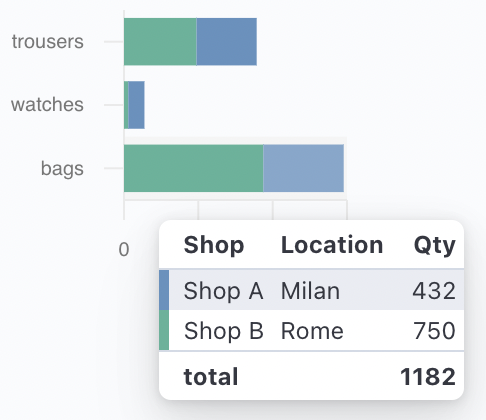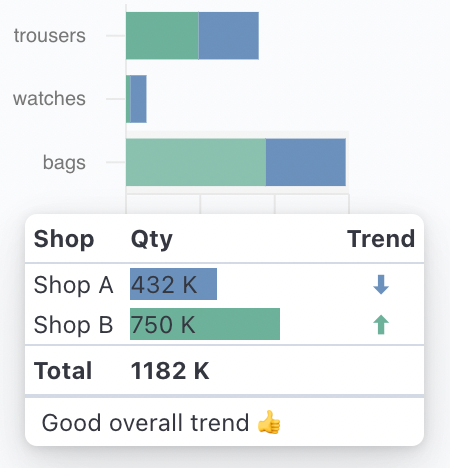-
Notifications
You must be signed in to change notification settings - Fork 118
Custom Tooltip
If the default behaviour is not enough for your use case, you can always define a custom tooltip reusing our set of composable components.
A custom tooltip can be specified through the <Tooltip> component within a chart configuration:
<Chart>
<Tooltip customTooltip={yourCustomTooltip} />
...
</Chart>The customTooltip prop accepts a React class component or a stateless functional component.
const yourCustomTooltip: CustomTooltip = ({ header, values }) => {
return (
<>
<TooltipHeader header={header} />
<TooltipTable columns={columns} items={values} />
</>
);
};Two main props are passed to the component (the same props used internally to render the tooltip):
-
header: TooltipValue<D, SI> | nullthat provides the information used to render an header. Currently only used by cartesian chart to render the current X-Axis value see Tooltip/Cartesian charts -
values: TooltipValue<D, SI>[]an array of data points that correspond to current cursor position (with some variations)
Both these props are filled with object that follows this signature:
Type Signature: TooltipValue
interface TooltipValue<D extends BaseDatum = Datum, SI extends SeriesIdentifier = SeriesIdentifier> {
/* The label of the tooltip value */
label: string;
/* The value */
value: any;
/* The formatted value to display*/
formattedValue: string;
/* The mark value */
markValue?: number | null;
/* The mark value to display */
formattedMarkValue?: string | null;
/* The color of the graphic mark (by default the color of the series) */
color: Color;
/* True if the mouse is over the graphic mark connected to the tooltip */
isHighlighted: boolean;
/* True if the tooltip is visible, false otherwise */
isVisible: boolean;
/* The identifier of the related series */
seriesIdentifier: SI;
/* The accessor linked to the current tooltip value */
valueAccessor?: Accessor<D>;
/* The datum associated with the current tooltip value */
datum?: D;
}You can render your own component, as in this example but is preferable to maintain the current look-and-feel used by the default tooltip by reusing our set of Tooltip Components.
These are the components that can be reused to render a custom tooltip:
TooltipHeader-
TooltipTableTooltipTableHeaderTooltipTableBodyTooltipTableFooter-
TooltipTableRowTooltipTableCellTooltipTableColorCell
TooltipFooterTooltipDivider
Except for the TooltipHeader, TooltipFooter and the TooltipDivider all the other components are wrappers around the HTML table element and its children.
The TooltipHeader is just a single bold line of text.
The signature is simple:
Type Signature: TooltipHeader
header: TooltipValue<D, SI> | null;
formatter?: TooltipValueFormatter<D, SI>;and can be just like this to render a simple header-only tooltip:
<Tooltip customTooltip={({header}) => <TooltipHeader header={header} formatter={(d) => `X: ${d.formattedValue}`} />} />The result is the following:

A TooltipTable renders a simple table by specifying the items and columns props or by manually composing a table with the provided components to render complex tables
Please, be aware that you are on a tooltip and the information you should render should be limited to just the essential
Using the columns and items props is a simplified way to render such a table. That props accept an array of columns descriptor with the following signatures:
Type Signature: TooltipTableColumnBase, TooltipTableColumnColor, TooltipTableColumnNumber, TooltipTableColumnText, TooltipTableColumnCustom
type TooltipTableColumnBase<D extends BaseDatum = Datum, SI extends SeriesIdentifier = SeriesIdentifier> = {
/* Identifier for column to be used in callbacks if needed */
id?: string;
/* ClassName to be applied to table cells within column (i.e. `td` or `th`) */
className?: string;
/* Table column header */
header?: string | ((items: TooltipValue<D, SI>[]) => string);
/* Table column footer */
footer?: string | ((items: TooltipValue<D, SI>[]) => string);
/* Boolean to hide entire column from table */
hidden?: boolean | ((items: TooltipValue<D, SI>[]) => boolean);
/* Limited styles to apply to table cells within column (i.e. `td` or `th`) */
style?: TooltipCellStyle;
};
interface TooltipTableColumnColor<D extends BaseDatum = Datum, SI extends SeriesIdentifier = SeriesIdentifier>
extends Omit<TooltipTableColumnBase<D, SI>, 'header' | 'footer'> {
type: 'color';
header?: never;
footer?: never;
}
interface TooltipTableColumnNumber<D extends BaseDatum = Datum, SI extends SeriesIdentifier = SeriesIdentifier>
extends TooltipTableColumnBase<D, SI> {
type: 'number';
/* Renders column cell element inside a `td` element */
cell: (item: TooltipValue<D, SI>) => string | number;
}
interface TooltipTableColumnText<D extends BaseDatum = Datum, SI extends SeriesIdentifier = SeriesIdentifier>
extends TooltipTableColumnBase<D, SI> {
type: 'text';
/* Renders column cell element inside a `td` element */
cell: (item: TooltipValue<D, SI>) => string;
}
interface TooltipTableColumnCustom<D extends BaseDatum = Datum, SI extends SeriesIdentifier = SeriesIdentifier>
extends TooltipTableColumnBase<D, SI> {
type: 'custom';
/* Renders column cell element inside a `td` element */
cell: (item: TooltipValue<D, SI>) => ReactNode;
}In general, you want to define your columns in an object and then pass it to the TooltipTable component like:
const columns: TooltipTableColumn<Datum, XYChartSeriesIdentifier<Datum>>[] = [
{ type: "color"},
{ type: "text", header: 'Shop', footer: 'total', cell: ({label}) => label },
{ type: "text", header: 'Location', cell: (d) => d.datum?.extra ?? ''},
{ type: "number", header: 'Qty', footer: (items) => `${items.reduce((s, d) => s + d.value, 0)}`, cell: (d) => d.value, style: {textAlign: 'right'} },
];
...
<Tooltip customTooltip={({values}) => <TooltipTable columns={columns} items={values} />} />The previous example renders a table like the following:

You can also compose a table by yourself with the following set of components:
TooltipTableHeaderTooltipTableBodyTooltipTableFooter-
TooltipTableRowTooltipTableCellTooltipTableColorCell
TODO add signature
You can compose the table as in the following example:
<Tooltip
customTooltip={({ header, values }) => (
<>
<TooltipTable>
<TooltipTableHeader>
<TooltipTableRow>
<TooltipTableCell tagName="th">Shop</TooltipTableCell>
<TooltipTableCell tagName="th">Qty</TooltipTableCell>
<TooltipTableCell tagName="th">Trend</TooltipTableCell>
</TooltipTableRow>
</TooltipTableHeader>
<TooltipTableBody>
{values.map((value) => (
<TooltipTableRow>
<TooltipTableCell>{value.label}</TooltipTableCell>
<TooltipTableCell>
<div style={{ width: 100 }}>
<div style={{ width: `${value.value / 10}%`, background: value.value < 500 ? '#6092C0' : '#54B399' }}>
{value.formattedValue} K
</div>
</div>
</TooltipTableCell>
<TooltipTableCell
style={{
textAlign: 'center',
}}
>
<div style={{ color: value.value < 500 ? '#6092C0' : '#54B399' }}>{value.value > 500 ? `⬆` : `⬇`}</div>
</TooltipTableCell>
</TooltipTableRow>
))}
</TooltipTableBody>
<TooltipTableFooter>
<TooltipTableRow>
<TooltipTableCell>Total</TooltipTableCell>
<TooltipTableCell>{values.reduce((s, d) => s + d.value, 0)} K</TooltipTableCell>
</TooltipTableRow>
</TooltipTableFooter>
</TooltipTable>
<TooltipFooter>
<span style={{ fontWeight: 'normal' }}>Good overall trend 👍</span>
</TooltipFooter>
</>
)}
/>that renders a table like the following:
